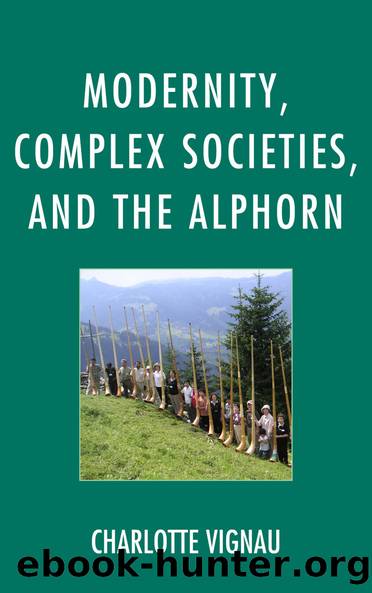Modernity, Complex Societies, and the Alphorn by Vignau Charlotte;

Author:Vignau, Charlotte; [Vignau, Charlotte]
Language: eng
Format: epub
Publisher: Lexington Books
Published: 2013-08-15T00:00:00+00:00
Chapter THREE
The Migration of the Alphorn Phenomenon
Three Case Studies: Allgäu, the Netherlands, and Japan
Alphorn practice outside Switzerland can be found in the United States, in Canada, Guatemala, France, and many more places. Here I will focus on three case studies: the Bavarian region of Allgäu in Germany, the Netherlands, and Japanâmore precisely the central island of Honshu (where Tokyo and Osaka are situated). In all three of the studies a direct link is traceable to Switzerlandâs alphorn culture, which in this book I regard as the center of alphorn-playing activity.
In all three situations, the migration of the alphorn phenomenon was connected to migration of people as a necessary factor for starting and developing an alphorn scene. While moving to and leaving Switzerland can be seen as permanent migration, there is also temporary migration for work reasonsâwhich in times past included travel by Swiss mercenary troopsâand leisure travel, better known as âtourismâ (also see van den Berghe 2007:552). Following on, the particular alphorn practices which mix endogenous cultural elements of their region with exogenous cultural elements of Switzerlandâor sometimes not of Switzerland itself but rather of an imagery of Switzerlandâwill be described, combined with the issue of migration.
Case Study One: AllgäuâBavaria
Many people emigrated from Switzerland at the beginning of the nineteenth century because of economic difficulties. More broadly speaking, emigration was taking place constantly from 1700 to 1900. While many emigrants went overseas to Brazil, Argentina, or the United States, for example, others stayed closer to home, which is often overlooked: âeven when, at the height of the migration overseas toward the end of the nineteenth century, half of the foreign-Swiss lived in European statesâ (Goehrke 1992:6, translation by the author). As Goehrke states in his introductory article about the research into emigration from Switzerland, moving overseas usually took place as organized mass emigration, and therefore left easily traceable evidence (see Goehrke 1992:7), for instance in (Swiss) archives. In addition to organized mass emigration, there was also collective migration from one village or town, as well as from one specific canton, to one area (see Goehrke 1992:12). But these sources and evidence are more difficult to obtain. As regards emigration from Switzerland to the rest of Europe, research has been carried out about emigrants in Russia (see Goehrke 1992:6), but Goehrke comments: âThe European countries which have been neglected until now, especially France and Germany, deserve increased attentionâ (Goehrke 1992:14, translation by the author). Where Germany is concerned, not so much is known yet about emigrants from Switzerland. From the poem Die Auswanderer (The emigrants) by poet and writer Ferdinand Freiligrath (see Freiligrath 1845:15) it seems that some of them went to the region of Spessart, Germany.1 It is also known that some went to the Allgäu region.
The German Allgäu region consists of a small, southeastern part of the federal state of Baden-Württemberg, and a neighboring, larger, southwestern part in the federal state of Bavaria, more precisely in the administrative district of Bavarian Swabia. The region of Allgäu is separated from
Download
This site does not store any files on its server. We only index and link to content provided by other sites. Please contact the content providers to delete copyright contents if any and email us, we'll remove relevant links or contents immediately.
Aircraft Design of WWII: A Sketchbook by Lockheed Aircraft Corporation(32220)
The Great Music City by Andrea Baker(31548)
Call Me by Your Name by André Aciman(20380)
The Secret History by Donna Tartt(18865)
The Art of Boudoir Photography: How to Create Stunning Photographs of Women by Christa Meola(18545)
Shoot Sexy by Ryan Armbrust(17663)
Plagued by Fire by Paul Hendrickson(17335)
Portrait Mastery in Black & White: Learn the Signature Style of a Legendary Photographer by Tim Kelly(16958)
Adobe Camera Raw For Digital Photographers Only by Rob Sheppard(16909)
Photographically Speaking: A Deeper Look at Creating Stronger Images (Eva Spring's Library) by David duChemin(16624)
Ready Player One by Cline Ernest(14534)
Pimp by Iceberg Slim(14401)
Bombshells: Glamour Girls of a Lifetime by Sullivan Steve(13981)
The Goal (Off-Campus #4) by Elle Kennedy(13544)
Art Nude Photography Explained: How to Photograph and Understand Great Art Nude Images by Simon Walden(12979)
Kathy Andrews Collection by Kathy Andrews(11739)
The Priory of the Orange Tree by Samantha Shannon(8898)
The remains of the day by Kazuo Ishiguro(8833)
Thirteen Reasons Why by Jay Asher(8802)
